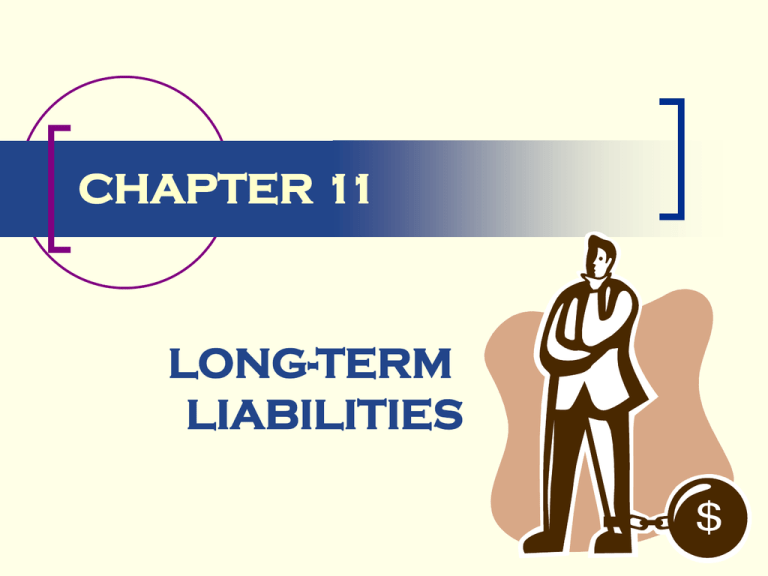
CHAPTER 11
LONG-TERM
LIABILITIES
Introduction
The importance of long-term debt
analysis
Debt
Equity
Theories of Liabilities
Entity theory:
Assets
Equities
Proprietary theory:
Assets
Liabilities
Current GAAP:
APB Statement No. 4
SFAC No. 6
Equities
Recognition and Measurement
of Liabilities
Theoretical measurement
criteria
Present value of future cash flows
Debt vs. Equity
Definition requires
classification of all right-hand
side items into either
liabilities or equity
Complex financial
instruments now in existence
make this difficult
Need additional criteria
Consolidated Set of Decision
Factors
Maturity date
Claim on assets
Claim on income
Market valuation
Voice in management
Maturity value
Intent of the parties
Consolidated Set of Decision
Factors
Preemptive right
Conversion factor
Potential dilution of EPS
Right to enforce payment
Good business reasons for
issuing
Identity of interest between
security holders
FASB Position on
Debt and Equity
FASB recognized that
problems exist
resurrected discussion
memorandum:
"Distinguishing between Liability and Equity
Instruments and Accounting for Instruments with
Characteristics of Both. "
The impetus is increasing use of complex
financial instruments
have both debt and equity characteristics
FASB Position on
Debt and Equity
Tentative conclusions have
led to development of an approach
based on characteristics of liabilities and equity.
Step 1: determine whether the component includes an
obligation.
Financial-instrument components that embody
obligations that require settlement by a transfer of cash
or other assets
Classify as liabilities
because they do not give rise to the possibility of establishing an
ownership interest by the holder.
FASB Position on
Debt and Equity
Obligations permitting or
requiring settlement by the issuance
of stock give rise to liability-equity
classification questions.
Classify component as liability if the
relationship is that of a debtor or creditor.
The proceeds of issuance of a compound
financial instrument that includes both liability
and equity components should be allocated to
its liability and equity components using the
relative fair-value unless that is impracticable.
Major Classifications of
Long Term Debt
Deferred
Taxes
Pensions
Bonds
Payable
Leases
Bonds Payable
Why businesses issue bonds
1 Only available source of funds
2 Debt financing has a relatively lower cost
3 Debt has a tax advantage
4 Voting privilege not shared
Trading on the equity
Bond Classifications
Mortgage
Debenture
Registered
Coupon
Bond Selling Prices
Stated vs. effective interest rate
Premium or discount
How is a bond selling price determined?
Example
XYZ Corporation sells
$100,000 of 10-year bonds
Stated interest rate of 10% to yield 9%
Interest on these bonds is payable
annually each December 31
Example
To calculate the bond selling price
PV of Principle
$100,000 X 0.422411
PV of Interest
$10,000 X 6.417658
Bond selling price
= $ 42,241.10
=
64,176.58
$106,417.68
For 12%, the same type of calculation will
result in a bond selling price of $88,699.53
Bond Issue Costs
Definition
Accounting treatment
Bond Interest Expense
Straight line
Effective interest
Zero Coupon Bonds
Definition
$100,000 @12% for 10-years
Issue price is $32,197
Discount is $67,803
Accounting treatment
Why popular?
Call Provisions
Early extinguishment of debt
Debt retirement
Debt refunding
ARB No. 43 possibilities
APB No. 26 requirements
SFAS No. 76
Debtor has paid creditor
Debtor legally released (legal defeasance)
Debtor places assets in trust fund (in-substance defeasance)
SFAS No. 125
In-substance defeasance not longer acceptable
Convertible Debt
Reason for issuing
Complex financial instrument
Current treatment is to ignore conversion
feature
Convertible Debt
Exposure draft suggested:
1 Classify based on the contractual terms
in effect at issuance.
2 Classify as a liability if the instrument
embodies an obligation to transfer
financial instruments to the holder if the
option were exercised.
3 Classify in accordance with the
fundamental financial instrument having
the highest value.
4 Classify based on the most probable
outcome.
Long-Term Notes Payable
Notes exchanged solely for cash
are presumed to carry an
appropriate rate of interest
Exchanges of notes for property,
goods and services cannot be
recorded at an inappropriate rate
of interest
If interest rate is clearly
inappropriate
FMV of property exchanged
FMV of note
Impute an interest rate
Short-Term Debt Expected
to be Refinanced
To classify as long-term must meet
two conditions:
1 Intent to refinance
2 Ability to refinance
Deferred Credits
Question: Are they
liabilities?
Usually based on the
necessities of doubleentry accounting
Contingencies
Gain
Loss
Accounting treatment
Other Liability
Measurement Issues
Off balance sheet
financing
SFAS No. 105
SFAS No. 107
Examples
Risks of loss due to credit
risk and market risk
Disclosures
Other Liability
Measurement Issues
Derivatives
Definition
Types:
1 Forward
2 Future
3 Option
4 Swap
5 Hybrid
SFAS No. 133
Derivative instrument:
any financial contract that provides the holder with the right (or
obligation) to participate in the price change of an underlying
asset
Must recognize all derivatives as assets and liabilities and
measure them at fair value
Derivative may be specified as:
a
b
c
Fair value hedge
Cash flow hedge
Hedge of foreign currency exposure
Gains or losses for hedges of net
investments in foreign subsidiaries reported as translation
adjustments in OCI
All others as income
Financial Analysis of
Long-Term Debt
Goal is to assess
Liquidity (covered in Chapter 7)
Financial Analysis of
Long-Term Debt
Solvency
Long term debt to assets ratio
Long-term debt
Total assets
Interest coverage ratio
Operating income before interest and taxes
Interest expense
Debt service coverage ratio
Cash flow from operating activities before interest and taxes
Interest expense
Financial Analysis of
Long-Term Debt
Financial flexibility
Performa financial statements
International Accounting
Standards
The IASC addressed the following
issues relating to long-term
liabilities:
1 Debt and equity classifications in IAS No. 32,
"Financial Instruments: Disclosure and
Presentation."
2 Contingencies in IAS No. 37, “Provisions,
Contingent Liabilities and Contingent
Assets”
3 Financial instruments in IAS No. 39,
“Financial Instruments - Recognition and
Measurement”
IAS No 32
Financial Instruments:
Disclosure and Presentation
Financial liabilities:
contractual obligations to deliver
cash or another financial asset to
another enterprise
or to exchange financial
instruments with another
enterprise under conditions that
are potentially unfavorable
Equity instruments
contracts that evidence a
residual interest in the assets of
an enterprise after deducting all
of its liabilities
IAS No 32
Financial Instruments:
Disclosure and Presentation
Requires companies to disclose
information about its financial
liabilities including:
1.
How they might affect the amount, timing,
and certainty of future cash flows
2.
The associated accounting policies and
basis of measurement applied.
The exposure of an enterprise's liabilities to
interest rate risk
Information about the fair value of an
enterprise’s financial liabilities
3.
4.
FASB Staff Review of IAS No 32
Accounting requirements for financial liabilities
contained in IAS No. 32
similar to those contained in SFAS No. 105
however, two differences were noted
1
IAS No. 32 was found to be more comprehensive in that it applies
to all financial instruments
whereas the requirements of SFAS No. 105
are only applicable to financial instruments
with off-balance sheet risk.
2
IAS No. 32 addresses the issues of both
disclosure and presentation
while SFAS No. 105 only addresses the
issue of disclosure.
FASB Staff Review of IAS No 32
As a result, it was suggested
that the financial reporting of financial
liabilities under the provisions of IAS No. 32
may result in more constant presentation
IAS No. 37
Provisions, Contingent Liabilities
and Contingent Assets
Recognize a contingency
when it is probable (more likely than not)
that resources will be required to settle
an obligation
and that the amount can be reasonably
estimated
FASB staff review noted the
difficulties U. S. companies have in
interpreting the term probable
Companies using international
standard will make this process even
more difficult because of the differing
definitions of the term
IAS No 39
Financial Instruments –
Recognition and Measurement
Financial liabilities are recognized and
initially measured at cost
Subsequently, most are amortized
derivatives and liabilities are remeasured at
fair market value
Remeasured liabilities may either be :
1
2
Recognized entirely in net profit or loss for
the period
Recognized in net profit or loss for
only financial liability held for trading
purposes
No FASB staff review
Prepared by
Richard Schroeder, DBA
Kathryn Yarbrough, MBA
Copyright © 2005 John Wiley & Sons, Inc. All rights reserved.
Reproduction or translation of this work beyond that permitted in
Section 117 of the 1976 United States Copyright Act without the
express written consent of the copyright owner is
unlawful. Requests for further information should be addressed to
the Permissions Department, John Wiley & Sons, Inc. The purchaser
may make back-up copies for his/her own use only and not for
distribution or resale. The Publisher assumes no responsibility for
errors, omissions, or damages, caused by the use of these programs
or from the use of the information contained herein.







